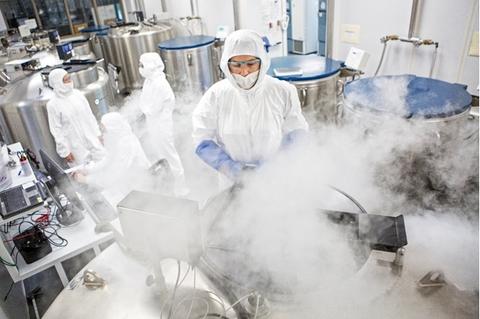Summary
NIST has been involved in archiving biospecimens for over 40 years through multiple projects of the former National Biomonitoring Specimen Bank (NBSB), established in 1979 (e.g., human livers, marine sediments, fish tissues, mussels, oysters, human diet samples) and the Marine Environmental Specimen Bank (ESB), established in 2002 (e.g. fish tissues, mussels, oysters, marine mammal tissues, seabird eggs and feathers, and sea turtle tissues and eggs). Today, these biospecimens are archived as a part of the NIST Biorepository located at the Hollings Marine Laboratory in Charleston, SC. This national biorepository is a unique resource that processes and preserves biospecimens at cryogenic temperatures (<-150 °C), as well as the associated data, that are maintained through multiple partner projects. Biospecimens are available to NIST scientists, as well as stakeholders, collaborators, and external researchers through formalized tissue access policies. The NIST Biorepository is managed and maintained by the Chemical Science Division’s Biospecimen Science Group.
nistbiorepository [at] nist.gov (NIST Biorepository Contact)
Description

Over 200,000 biospecimens are stored in liquid nitrogen vapor-phase freezers at the NIST Biorepository, located at the Hollings Marine Laboratory in Charleston, SC.
The NBSB was established in 1979 at NIST in Gaithersburg, MD with a pilot project archiving human liver samples associated with collections through the Environmental Protection Agency (EPA). New collaborations and banking projects were established including the National Oceanic and Atmospheric Administration’s (NOAA’s) long-term monitoring project, the National Status and Trends Mussel Watch Project (NS&T/MWP) and the NOAA Exxon Valdez Oil Spill Damage Assessment. As NIST became more involved with specimen banking, the focus turned toward marine animal collections, including NOAA National Marine Fisheries Service’s (NMFS) National Marine Mammal Tissue Bank (NMMTB), formally established by the Marine Mammal Health and Stranding Response Act (Public Law 102-587). In 2002, the Hollings Marine Laboratory opened its doors in Charleston, SC and the Marine ESB was established as a NIST satellite facility. In 2010 the NBSB was permanently closed and all collections were transferred to the Marine ESB. Today collections from both the NBSB and the Marine ESB are maintained and managed as a part of the NIST Biorepository located in the Hollings Marine Laboratory, Charleston SC.
The long-term preservation of representative biospecimens for deferred analysis and evaluation is not only a valuable component of real-time monitoring and basic research, but it also enables investigators to extend their research into the past and provides for future verification of analytical results. Formal biospecimen banking is recognized internationally as an integral part of long-term research and monitoring.
Biospecimens have been used for documenting geographic and temporal trends in legacy compounds and compounds of emerging concern, cellular and biomolecular measurements, RNA analysis for genetics and evolutionary studies, proteomic and metabolomic analyses as well as food web studies through stable isotope and fatty acid analysis.
Active projects today include specimens that are collected and archived from the marine and coastal environment of the USA, including Alaska and the Pacific Islands Region. Projects of the NIST Biorepository are specifically designed to cryogenically store specimens over long periods of time (50-100 years). With input from our stakeholders, standardized protocols are developed by NIST for collecting, processing and archiving tissues and fluids with integrity and quality control to ensure sample stability and reproducibility that supports critical measurements. The biospecimens and associated metadata are collected in order to:
- provide sufficient material for multiple analyses,
- minimize the possibility of sample change and/or loss during storage,
- minimize inadvertent contamination during sample handling and ensure sample integrity,
- provide for long-term sample stability through cryogenic techniques, and
- track and maintain a record of sample history, from time of collection to downstream analysis.
Additional Facility Details
LABORATORY
SPACE
EQUIPMENT
ISO Class 5 sample processing laboratory
ISO Class 7 cryogenic storage facility and reference material production facility
Support: ante rooms; office space
Liquid Nitrogen (LN2) vapor-phase freezers (auto-fills)
Ultra-cold (-80 °C) electric upright freezers with LN2 backup
Cryogenic Vibrating Disc Mills
Laser Diffraction Particle Size Analyzer
Monitoring/security system for freezers and room conditions (temperature, humidity, % oxygen)
Biospecimen Inventory Management System
ACTIVE PROJECTS AT THE NIST BIOREPOSITORY
- National Marine Mammal Tissue Bank (NMMTB) (including the Marine Mammal Health and Stranding Response Program and the Alaska Marine Mammal Tissue Archival Project)
- Seabird Tissue Archival and Monitoring Project (STAMP)
- San Francisco Estuary Institute Biobanking Project (SFEI)
- Biological and Environmental Monitoring and Archival of Sea Turtle Tissues (BEMAST)
- Marine-Related Disaster Response
- NOAAs National Status and Trends (NS&T)
PROCEDURES AND PROJECT DOCUMENTATION
Ellisor, D. , Pugh, R. , Buzby, N. , Weaver, M. and Foley, M. (2021), The San Francisco Estuary Institute Collection at the NIST Biorepository, NIST Interagency/Internal Report (NISTIR), National Institute of Standards and Technology, Gaithersburg, MD.
Lynch, J. , Pugh, R. and Becker, P. (2014), BIOLOGICAL AND ENVIRONMENTAL MONITORING AND ARCHIVAL OF SEA TURTLE TISSUES (BEMAST): Rationale, Protocols, and Initial Collections of Banked Sea Turtle Tissues, NIST Interagency/Internal Report (NISTIR), National Institute of Standards and Technology, Gaithersburg, MD.
Schuur, S. , Becker, P. , Berail, S. , Day, R. , Donard, O. , Hobson, K. , Moors, A. , Pugh, R. , Rust, L. and Roseneau, D. (2012), SEABIRD TISSUE ARCHIVAL AND MONITORING PROJECT: Egg Collections and Analytical Results for 2006-2009, NIST Interagency/Internal Report (NISTIR), National Institute of Standards and Technology, Gaithersburg, MD.
Pugh, R. S., Becker, P. R., Porter, B. J., Ellisor, M. B., Moors, A. J., and Wise, S. A., "Design and applications of the National Institute of Standards and Technology's (NIST's) environmental specimen banking programs," Cell Preservation Technology, 6, 59-72 (2008).
Pugh, R. , Ellisor, M. , Moors, A. , Porter, B. and Becker, P. (2007), Marine Environmental Specimen Bank: Clean Room and Specimen Bank Protocols, NIST Interagency/Internal Report (NISTIR), National Institute of Standards and Technology, Gaithersburg, MD.
Becker, P. , Porter, B. , Mackey, E. , Schantz, M. , Demiralp, R. and Wise, S. (1999), National Marine Mammal Tissue Bank and Quality Assurance Program: Protocols, Inventory, and Analytical Results, NIST Interagency/Internal Report (NISTIR), National Institute of Standards and Technology, Gaithersburg, MD

